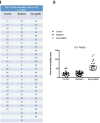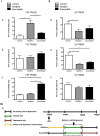Behavioral and cognitive impact of early life stress: Insights from an animal model
- PMID: 28527907
- PMCID: PMC5613976
- DOI: 10.1016/j.pnpbp.2017.05.015
Behavioral and cognitive impact of early life stress: Insights from an animal model
Abstract
Background: Children subjected to traumatic events during childhood are reported to exhibit behavioral and cognitive deficits later in life, often leading to post-traumatic stress disorder (PTSD) and major depression. Interestingly, some children continue to remain normal despite being exposed to the same risk factors. These trauma-related behavioral and cognitive profiles across different stages of life are not well understood. Animal studies can offer useful insights.
Objective: The goal of this study was to determine the impact of early life exposure to traumatic events on behavioral and cognitive profile in rats by tracking the behavior of each rat at different ages.
Methods: We utilized the single prolonged stress (SPS), a rodent model of PTSD, to study the effects of early life stress. Male Sprague-Dawley rats were exposed to SPS on post-natal day (PND) 25. Tests to assess anxiety- and depression-like behavior, as well as learning and memory function were performed at PND32, 60 and 90.
Results: Rats exposed to SPS exhibited both anxiety- and depression-like behavior at PND32. And, short-term (STM) but not long-term memory (LTM) was impaired. Rats exposed to SPS at PND60 exhibited anxiety- but not depression-like behavior. STM but not LTM was impaired. Rats exposed to SPS at PND90 exhibited fearful (as indicated by elevated plus maze test) but not an overall anxiety-like behavior (in light and dark test). These rats also displayed significant depression-like behavior with no changes in STM or LTM. Interestingly, when data was further analyzed, two subsets of PND90 rats exposed to SPS were identified, "susceptible": with depression-like behavior and "resilient": without depression-like behavior. Importantly, while resilient group expressed early signs of anxiety- (at PND32 and PND60) and depression-like behavior (at PND32), these behavioral deficits were absent at PND90. On the other hand, susceptible PND90 rats exposed to SPS expressed later onset of anxiety-like behavior (at PND60), while depression-like phenotype was evident only later on at PND90.
Conclusions: Our findings suggest that early life stress caused co-occurrence of anxiety and depression-like behavior at PND32 (mimics human early-adolescent period). This co-occurrence was lost at PND60 with demonstration of anxiety- but not depression-like behavior. Later, depression but not anxiety-like behavior was observed at PND90. It seems that behavioral adaptations occur at the critical PND60 stage (mimics human late-adolescent period), where behavioral and cognitive switching occurs, thereby, expressing susceptible and resilient phenotypes.
Keywords: Early life stress; PTSD; Psychological stress; Resilience; Trauma.
Published by Elsevier Inc.
Conflict of interest statement
Figures






Similar articles
-
Behavioral effects of early life maternal trauma witness in rats.Prog Neuropsychopharmacol Biol Psychiatry. 2018 Feb 2;81:80-87. doi: 10.1016/j.pnpbp.2017.10.013. Epub 2017 Oct 24. Prog Neuropsychopharmacol Biol Psychiatry. 2018. PMID: 29074097 Free PMC article.
-
Microbial composition, functionality, and stress resilience or susceptibility: unraveling sex-specific patterns.Biol Sex Differ. 2024 Feb 26;15(1):20. doi: 10.1186/s13293-024-00590-7. Biol Sex Differ. 2024. PMID: 38409102 Free PMC article.
-
Prior treadmill exercise promotes resilience to vicarious trauma in rats.Prog Neuropsychopharmacol Biol Psychiatry. 2017 Jul 3;77:216-221. doi: 10.1016/j.pnpbp.2017.04.018. Epub 2017 Apr 18. Prog Neuropsychopharmacol Biol Psychiatry. 2017. PMID: 28428145 Free PMC article.
-
Single prolonged stress: toward an animal model of posttraumatic stress disorder.Depress Anxiety. 2009;26(12):1110-7. doi: 10.1002/da.20629. Depress Anxiety. 2009. PMID: 19918929 Review.
-
[Posttraumatic stress disorder (PTSD) as a consequence of the interaction between an individual genetic susceptibility, a traumatogenic event and a social context].Encephale. 2012 Oct;38(5):373-80. doi: 10.1016/j.encep.2011.12.003. Epub 2012 Jan 24. Encephale. 2012. PMID: 23062450 Review. French.
Cited by
-
Potential resilience treatments for orangutans (Pongo spp.): Lessons from a scoping review of interventions in humans and other animals.Anim Welf. 2023 Dec 4;32:e77. doi: 10.1017/awf.2023.97. eCollection 2023. Anim Welf. 2023. PMID: 38487448 Free PMC article.
-
Omega-3 Fatty Acids Prevent Post-Traumatic Stress Disorder-Induced Memory Impairment.Biomolecules. 2019 Mar 12;9(3):100. doi: 10.3390/biom9030100. Biomolecules. 2019. PMID: 30871113 Free PMC article.
-
Early Life Sleep Deprivation: Role of Oxido-Inflammatory Processes.Neuroscience. 2019 May 15;406:22-37. doi: 10.1016/j.neuroscience.2019.02.021. Epub 2019 Mar 1. Neuroscience. 2019. PMID: 30826520 Free PMC article.
-
Understanding the relationships between physiological and psychosocial stress, cortisol and cognition.Front Endocrinol (Lausanne). 2023 Mar 6;14:1085950. doi: 10.3389/fendo.2023.1085950. eCollection 2023. Front Endocrinol (Lausanne). 2023. PMID: 36950689 Free PMC article. Review.
-
Early-Life Adversity Induces Epigenetically Regulated Changes in Hippocampal Dopaminergic Molecular Pathways.Mol Neurobiol. 2019 May;56(5):3616-3625. doi: 10.1007/s12035-018-1199-1. Epub 2018 Sep 1. Mol Neurobiol. 2019. PMID: 30173406 Free PMC article.
References
-
- Boersma GJ, Bale TL, Casanello P, Lara HE, Lucion AB, Suchecki D, Tamashiro KL. Long-term impact of early life events on physiology and behaviour. J Neuroendocrinol. 2014;26(9):587–602. - PubMed
-
- Bremner JD. Does stress damage the brain? Biol Psychiatry. 1999;45(7):797–805. - PubMed
-
- Hoffman AN, Krigbaum A, Ortiz JB, Mika A, Hutchinson KM, Bimonte-Nelson HA, Conrad CD. Recovery after chronic stress within spatial reference and working memory domains: correspondence with hippocampal morphology. Eur J Neurosci. 2011;34(6):1023–1030. - PubMed
Publication types
MeSH terms
Grants and funding
LinkOut - more resources
Full Text Sources
Other Literature Sources
Medical

